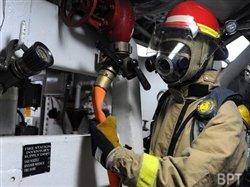Be at the Navy’s Hub: operate state-of-the-art nuclear powered vessels
(BPT) - Maintain equipment used to detect enemy planes and ships. Control steam generators. Operate nuclear propulsion plant machinery. These are just a few of the tasks Sailors aboard Navy aircraft carriers and submarines fulfill in both peace and wartime roles around the world. These Sailors are responsible for operating, controlling and maintaining state-of-the-art nuclear components that power the fleet; the core of the Navy’s ability to operate forward and maintain readiness.
Today’s Sailors continue to make history. They take on tremendous roles and responsibilities such as working to build the Gerald R. Ford, a new class of carriers expected to be delivered in 2015. Aircraft carriers are the centerpiece of the Navy, and the Gerald R. Ford class builds upon the branch’s legacy of aircraft carrier innovation stretching back to the first aircraft carrier, USS Langley (CV 1) and continuing to the present day. The introduction of jet aircraft, angled decks and nuclear power were all innovations that kept the fleet relevant for Cold War needs. Gerald R. Ford continues the aircraft carrier history of modernization and adaptability that will enable her to serve our country for decades to come. Sailors in the nuclear community are involved in maritime security, sea control, deterrence, humanitarian assistance, forward presence and power projection. Submarines and their crews provide attack, surveillance, research and nuclear deterrence roles.
Sailors interested in joining an elite group of professionals who design, build, operate, maintain and manage the Navy’s nuclear-powered ships and submarines can join the Nuclear Officers in the Naval Nuclear Propulsion Program. These officers oversee the nuclear reactors that power the Navy’s vessels, as well as the facilities that support the program’s ongoing training, operations and technology.
The Navy has four specialized Nuclear Officer career paths available for Sailors who are a graduate or student of an accredited college or university in the United States or in a U.S. territory pursuing a bachelor’s or master’s degree (in the preferred fields of mathematics, engineering, physics, chemistry or other technical areas). They must also have completed or be enrolled in a college curriculum that includes a minimum of one year each of calculus-based physics and mathematics through integral calculus. These career paths are:
* Submarine Officer – This position oversees the specialized personnel, departments and missions of Navy attack, ballistic missile and guided missile submarines – taking charge of all that goes into driving, powering, arming, operating and ultimately commanding these stealth vessels.
* Surface Warfare Officer – These specialists oversee the propulsion systems and personnel aboard multibillion dollar, megaton, nuclear-powered aircraft carriers – managing the operational intricacies of the most capable ships on earth.
* Naval Reactors Engineer – These technical experts are responsible for researching, designing and maintaining Naval nuclear reactors across the Navy Fleet – supporting all the activities involved with ongoing operations and personnel training.
* Naval Nuclear Power School Instructor – Be one of the select few who learn and then teach the fundamentals of nuclear propulsion – guiding Navy understudies through a comprehensive curriculum, encompassing everything from science to math, electrical engineering to reactor dynamics.
Other nuclear power careers are available for Sailors with a high school diploma or GED. These Nuclear Operations personnel operate, control and maintain the state-of-the-art components that power Navy aircraft carriers and submarines, doing anything from operating nuclear propulsion plant machinery to controlling auxiliary equipment that supports Naval reactors to maintaining the electronic equipment used to send and receive messages, detect enemy planes and ships and determine target distance.
Jobs available for nuclear-trained specialists include:
* Machinist’s Mate (MM) – These specialists work on the mechanical side of everything related to propulsion and power-generating systems.
* Electrician’s Mate (EM) – EM’s work on the electrical side of everything related to propulsion and power-generating systems.
* Electronics Technician (ET) – An ET works with the electronic equipment related to maintaining reactor safety and control.
Visit navy.com to learn more about Nuclear Operations career opportunities and the background required to serve.







